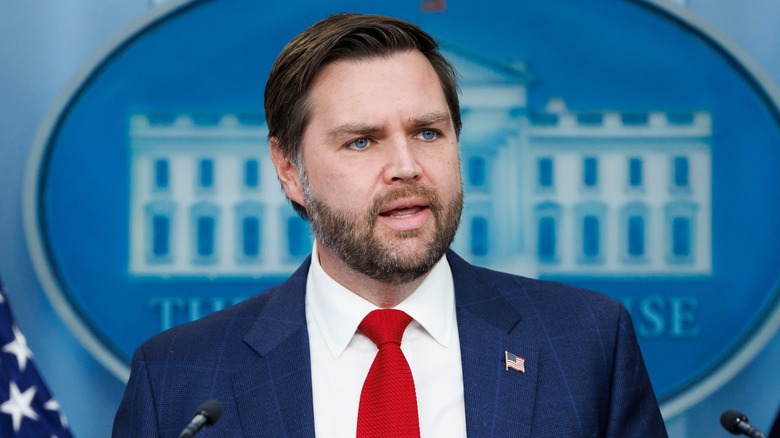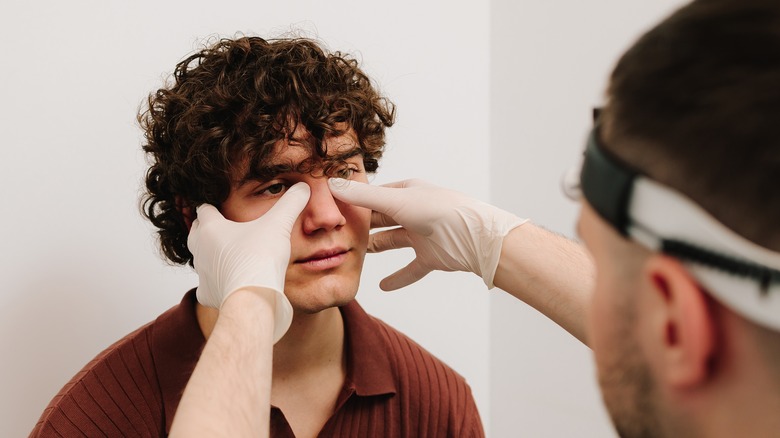JD Vance Had A Medical Procedure You Probably Didn't Hear About
Vice President JD Vance managed to slip away to George Washington Hospital in Washington for a minor sinus surgery just a few weeks before he was sworn into his White House role. You might not have heard much about it because he had attended the swearing-in ceremony for the newly elected senators earlier that day. Vance's spokesperson William Martin said the surgery had been scheduled for a while, and Vance was expected to be back to work the next day (via Fox News).
(Learn which health conditions make you more likely to develop nasal polyps.)
The two-hour procedure was a functional endoscopic sinus surgery (FESS), also known simply as endoscopic sinus surgery (per Times of India). This type of surgery is usually done when blockages in the nasal cavity prevent mucus from draining properly. Those blockages can cause pain or breathing issues. Endoscopic sinus surgery is minimally invasive, which means there's no need for any external incisions. Instead, the surgeon inserts a small tube through the nostrils and uses surgical tools to remove anything causing the blockage, like bone, tissue, or polyps (per Cleveland Clinic).
What endoscopic sinus surgery involves
Although it's not clear what specific sinus issues Vance was dealing with, many people end up needing endoscopic sinus surgery when antibiotics or nasal sprays don't relieve their symptoms. People with tumors in their sinuses, nasal polyps, or chronic sinus infections may opt for this type of surgery. It typically helps reduce sinus infections, improves breathing, and can even restore the sense of smell. Sometimes, blockages prevent medications or nasal rinses from reaching the sinuses effectively, so endoscopic sinus surgery can help in those cases.
Endoscopic sinus surgery is an outpatient procedure, but it still requires general anesthesia. Patients need to avoid eating or drinking the day of the surgery to reduce the risk of complications from the anesthesia. Since Vance's surgery was scheduled for the afternoon, that meant he attended the Senate swearing-in ceremony earlier that day without food or water. He also needed a ride home afterward because of the anesthesia. Generally, people preparing for this surgery are advised to stop smoking at least three weeks before the procedure. Those taking aspirin or blood thinners may need to pause those medications about a week in advance to minimize the risk of excessive bleeding.
Recovering from endoscopic sinus surgery
After endoscopic sinus surgery, people typically need to use nasal sprays every few hours to ease discomfort. To help clear out any remaining debris, they'll also need to use a sinus rinse kit twice a day to irrigate the sinuses. Some bleeding, nasal pressure, and fatigue are common for a few days after the procedure. Nasal congestion may also occur, but the sinuses usually clear up within a few weeks.
(Read about which foods to limit if you have sinusitis.)
Although endoscopic sinus surgery is minimally invasive, rare complications can still occur. According to the American Academy of Family Physicians, the most serious risk is damage to the optic nerve, which can result in blindness. There's also a small chance of cerebrospinal fluid leaking during surgery, though this is often detected and repaired right away. A clear nasal discharge after surgery may be a sign of this complication. Other rare side effects include bruising around the eye or a blocked tear duct, though these are even less common than in traditional sinus surgeries.


